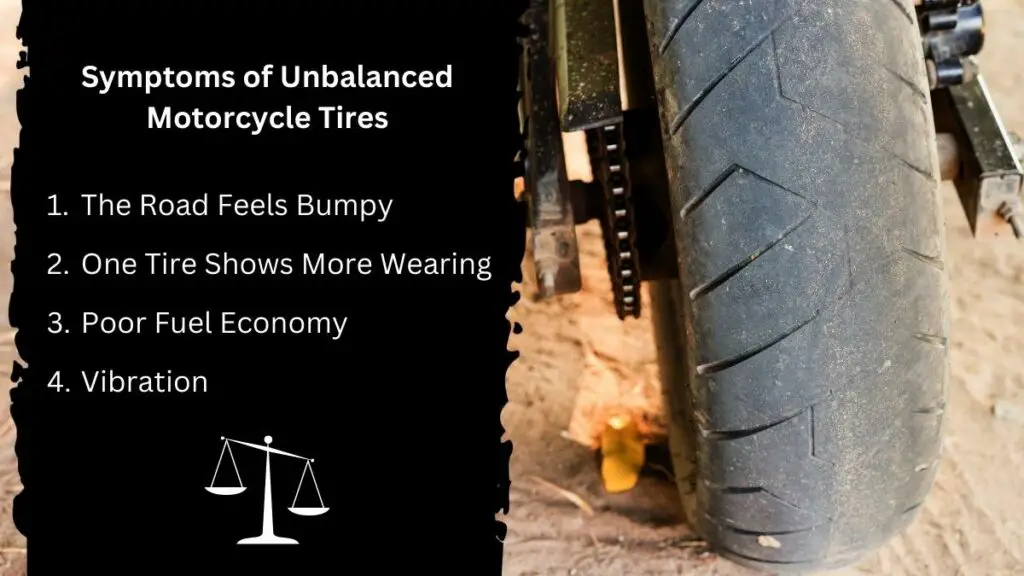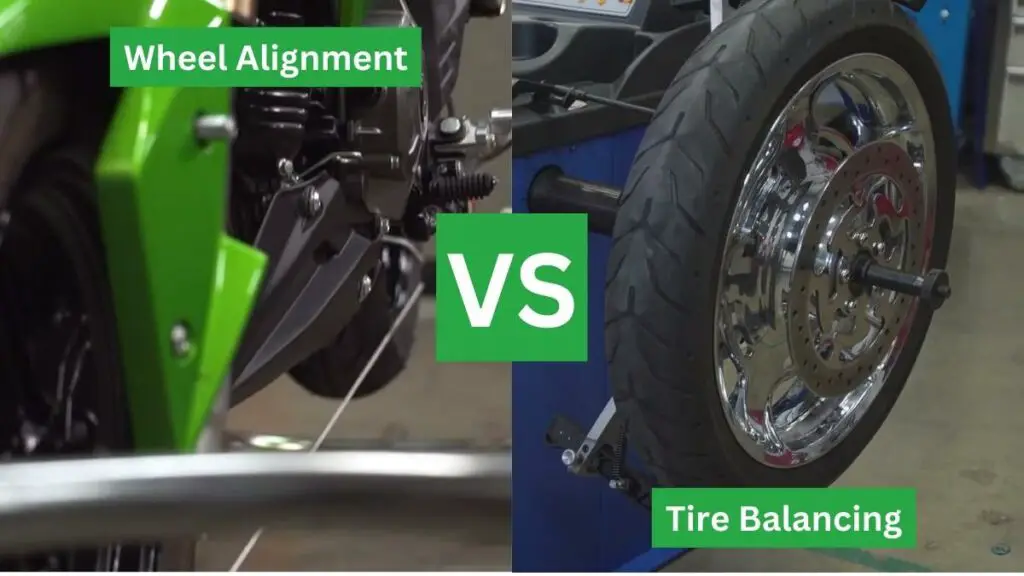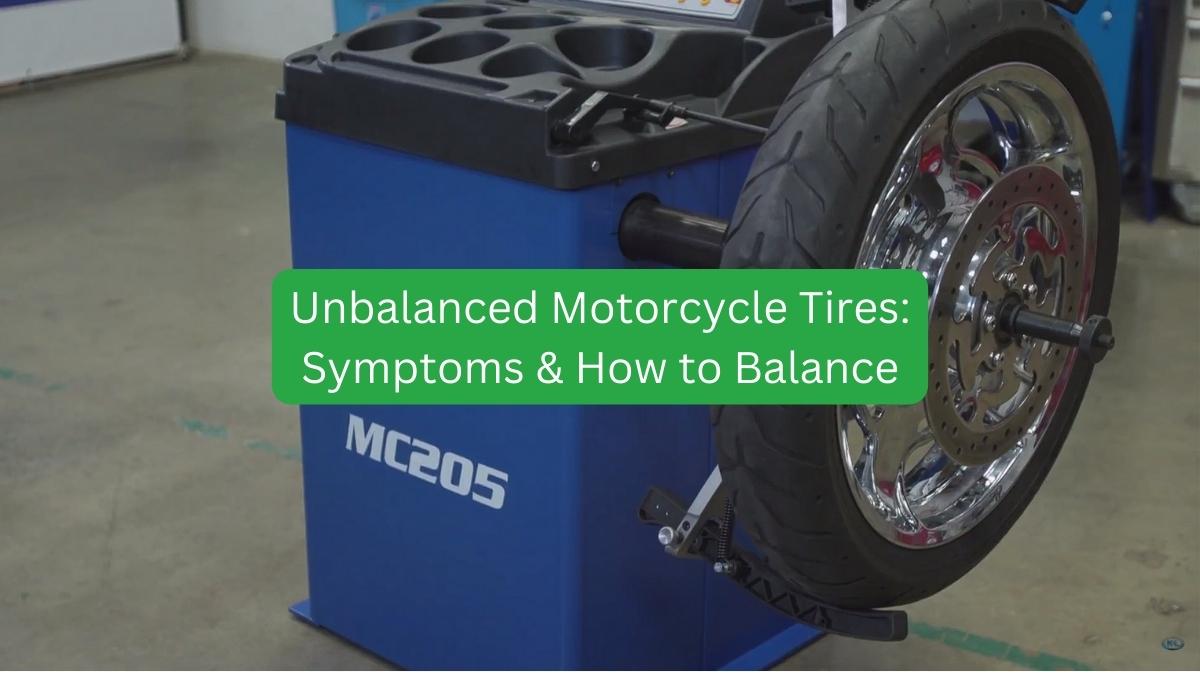To most riders, balancing motorcycle tires is always an afterthought when everything else is taken care of.
However, ignoring tire balance could affect weight distribution, handling, and safety.
To avoid any accidents and damages, make it your habit to check your tires and keep them in great condition frequently.
Most riders forget that the subtle signs of imbalance can be considered road troubles. But, unfortunately, in the long run, ignoring these signs will lead to bigger and more expensive troubles.
So now that you are here, we will guide you through the telltale signs of your motorcycle tires being out of balance.
Once you understand these symptoms, we will also provide a detailed guide on how you can balance your motorcycle in your own garage without any stress.
Learn more about what balancing your motorcycle wheels means to you and your bike.
What Causes Tires to be Out of Balance?
When tires are in balance, they uniformly distribute the weights of the wheel and tire around the axle. When riding on the road, the weight distribution shifts as you keep using your motorcycle with similar sets of tires. The weight shifts add up, causing the tires to be out of balance.
Tires constantly wear when they come into contact with potholes, pavements, and rough roads. Such prolonged wear could cause tire imbalance, and sharp turns over curbs also stress the tires.
If your motorcycle is for off-road conditions, check it after every drive to ensure it is properly aligned. A visible inspection will tell you that the motorcycle tires need replacement or balancing.
Symptoms of Unbalanced Motorcycle Tires

1. The Road Feels Bumpy
The easiest way to tell a tire is not well balanced is a bumpy feel when riding at normal speeds. The differences between the tires may not be as significant, but even a 50-gram difference can make riding very risky.
If you are experiencing a bumpy ride, consider parking your motorcycle and finding a balancing solution like balancing beads.
2. One Tire Shows More Wearing
Performing a visual check on your tires could help you identify the problematic one. For example, you will notice that one tire is unbalanced because it is more worn out on one end.
This sign is enough to prompt you to find a quick solution that makes the riding experience less efficient because you will need to replace the unbalanced tires faster.
3. Poor Fuel Economy
A poor fuel economy could indicate many things, but your first guess should be the tires. Fuel economy is easily noticeable because your wallet will take a hit when your fuel performance declines.
In addition, driving with poorly balanced tires means your engine is working harder to compensate for the weight the imbalance is putting on it. As a result, this process uses a lot of fuel.
4. Vibration
Motorcycle unbalanced tires cause too much vibration that ruins the riding experience. The vibration effects are noticeable in the handlebars and the seats.
The severity of the vibration depends on the level of imbalance on the tires. Even road conditions and speed may also affect vibration.
Difference Between Tire Balancing and Wheel Alignment

Wheel alignment and tire balancing are different, but both are concerned with regular motorcycle maintenance. Aligning the wheels involves correcting tire angles to rectify their position, as recommended by motorcycle manufacturers.
Alignment gets the wheels traveling in the same direction and ensures that tires are perfectly contacting the ground effectively. Wheel alignment does not happen too often, and the technician will inspect the tire for any good signs of poor alignment and wheel orientation.
Wheel balancing should be a frequent practice because it affects weight distribution around the tire. During wheel balancing, the technician uses a calibrated spin balancer and checks the static and dynamic wheel balance.
Types of Tire Balancing
1. Static
The uneven tires are mounted vertically in static balancing with a spindle tool. The process can also use a bubble balancer that adds weight across one tire line. This is the easiest and most efficient method for light cases of out-of-balance tires.
2. Dynamic
Dynamic balancing is a process where you mount a tire on a machine that spins at certain speeds. The machine measures the weight and provides information on the amount of weight to be added. The balancer will show stiff spots in motorcycle tires when there is an imbalance.
3. Read Force
Read force balancing is an advanced and precise method than dynamic and static balancing. It creates simulations of road conditions where tires are placed under a large roller to exert the estimated weight of the motorcycle.
A computer then shows variations in the tread and translates the reading indication on the source of the problem. Finally, the technician takes the measurements to rematch the wheel and the tire.
Tips for Balancing Motorcycle Tires
A few tips can make the tire balancing process easier and faster. Some of the tips to take note of include the following;
Checking the Tires When Cold
If the motorcycle tire is hot, you will not get accurate readings. Give the tires time to cool down before you start the balancing process.
Using a Quality Balance Stand
It is crucial to use a quality balance stand when balancing your tires. A good stand maintains a level surface and has adjustable arms holding the wheel.
Removing any Weights from the Wheel
If your tires have wheels, remove them before you start the process of balancing. This ensures you get accurate readings.
Adding Weight to the Lightest Spots
Add weight to the tire until it is properly balanced and you have found the lightest spot. It would help if you used a suitable weight to keep the tire within the balance limits.
Regularly Check the Balance
Regularly checking the balance beads is critical after you have balanced the tires. Doing this ensures that the tires stay balanced and will help you extend the life of the bearings and wheels.
How to Balance Motorcycle Tires
Step 1: Set up the Balancer
- It would help if you first took the motorcycle wheel off by loosening the lug nuts using a wrench. Next, safely store the lug nuts and take off the wheel.
- Set the balancer on a flat surface whether you are using a static or dynamic balancer. Pick an even and stable location.
- Test the balancer using a level to ensure it is properly even. Place the level over the balancer and use masking tape if it does not stay in position. Move it around until you find an even ground.
- The metal rod on the balancer has two cones facing outwards. Pull one of the cones sideways and slide the wheel onto the rod by pushing the axle sleeve onto the cone. Next, slide the cone back onto the balancer rod and push forward until it fits inside the axle sleeve.
- Degrease the rim using a contact cleaner to wipe off the rim and remove any debris that could affect the balancing test. This debris is notorious for skewing the balance test results.
Step 2: Even the Wheel’s Weight
- Start by gently spinning the tire and waiting for it to stop. Spin it 2 or 3 times and slow down the tire with your hands if you apply heavy force. Once the tire stops, the heaviest part will be at the bottom.
- Use masking tape to mark the lowest point on the wheel. You can also use chalk because this point will guide the balancing process.
- Tape a wheel weight on the top end of the rim, which is opposite to the lowest end you marked. This part is the wheel’s lightest point, and do not stick the weights directly.
- Rotate the tire to spin it until the taped side, and the side with weights stops on the right and left. Then, release the wheel and let it stop on its own for the heaviest side to stop at the bottom.
- Add more weights to balance the wheel to the lightest part, always at the top. If the part with the weight is at the top, it shows that the part is still light. However, if it stops at the bottom, the side is too heavy, and you must remove some weight.
- Stop adding weight when the wheel stops rotating on its own. Test the wheel again by rotating until the heavy and light sides are on the left and right, respectively. A balanced tire will not move, and the heaviest side will not fall back at the bottom. Test for a few more minutes to get conclusive results.
- Before replacing the wheel, secure the weights in place. Rotate the weighted parts to the bottom, remove the adhesive backing on the weights, and press them to fit on the rim. Keep them inside the rim beside the spokes, move the wheel back onto your bike, and enjoy the ride.
Problems of Riding Unbalanced Tires
While unbalanced tires can cause many different problems, here are some common ones:
They Cause Tire Failure
One of the biggest disadvantages of unbalanced motorcycle tires is that they can cause the tire to fail massively. This happens because uneven weight distribution adds extra weight to the tire and can cause a blowout.
Possible Wheel Damage
If you ride unbalanced motorcycle tires for a long time, they can lead to damage to the wheel. The wheel can wrap or even break under high pressure.
Damage to the Suspension
Unbalanced motorcycle tires are some of the biggest dangers to the motorcycle’s suspension. The uneven weight distribution causes the shocks to wear out prematurely.
Bike Drifting and Wandering
While damage to your motorcycle is hazardous, your ride can also be affected. Drifting and wandering the bike can affect the bike’s handling, especially when riding uphill or with a group. It will keep moving sideways and, if not checked on time, may cause accidents.
Poor Fuel Efficiency
Unbalanced motorcycle tires can lead to poor fuel efficiency because of uneven weight distribution. In addition, the engine will be overworked and thus demand more fuel to keep running. The only way to solve all these problems is by regularly balancing the tires.
Conclusion
Now you know what to look for when your motorcycle tires are poorly balanced. You can do the balancing at home; despite the tedious process, you will save time.
If you do not want to get your hands dirty, consider hiring a professional to do it for you. Ensure that you complete numerous tests to ensure the tires are properly balanced.
Frequently Asked Questions
Are Tire Balancing Weights the Same Size?
When trying to find the best weight for balancing your tire, it is recommendable to choose high-quality steel weights instead of cheap plastic ones. While plastic is a cheaper option and accessible at all levels, it can be very problematic.
Additionally, plastic weights are not built for motorcycles and should not be considered a viable option when looking for better balancing equipment. Therefore, you should get steel weights because they are the best fit for all types of motorcycle tires.
Never overlook the matter of getting motorcycle weights. The two factors to critically consider are material and weight capacity size.
Do you Need to Balance Motorcycle Tires?
Yes. It is advisable to balance your motorcycle tires to avoid constant vibration and damage to the motorcycle. Motorcycles are smaller than other vehicles and sometimes become unstable when riding at higher speeds. The best way to solve this problem is by checking tire pressure and wheel alignment.
If your tire has bumpy treads, it may cause excessive rotation and heat buildup. A soft and flat tire can cause tire imbalance when riding. With a properly balanced motorcycle tire, you are assured of riding safely. It allows better vehicle control, reduces the likelihood of a blowout, and prevents uneven wearing.
Can I Balance Tires Myself?
Yes. You can balance motorcycle tires independently, but you must remember to check in with a professional first. However, if you do it properly, balancing might improve your ride quality saving you costs in the long run.
How Long Does It Take to Balance a Tire?
Balancing motorcycle tires is very short, and you can complete the task within 20 minutes. This process, however, depends on the size and weight of the motorcycle tires you are using.
How often Should you Balance Motorcycle Wheels?
It is recommendable to check the motorcycle tires before each journey to check for signs of damage and wearing. Also, check the tire pressure weekly to ensure it is still balanced. If you find any signs of wearing in the visual check, it could either be a sign of imbalance or misalignment.
Hi, my name is Niklas, the head content creator & CEO of Whirling Wheelz. I am very interested in vehicles of all kinds, mainly cars. I have a car mechanics degree from high school and a big hobby of mine is to follow the WRC (World Rally Championship) both online and through travel.


